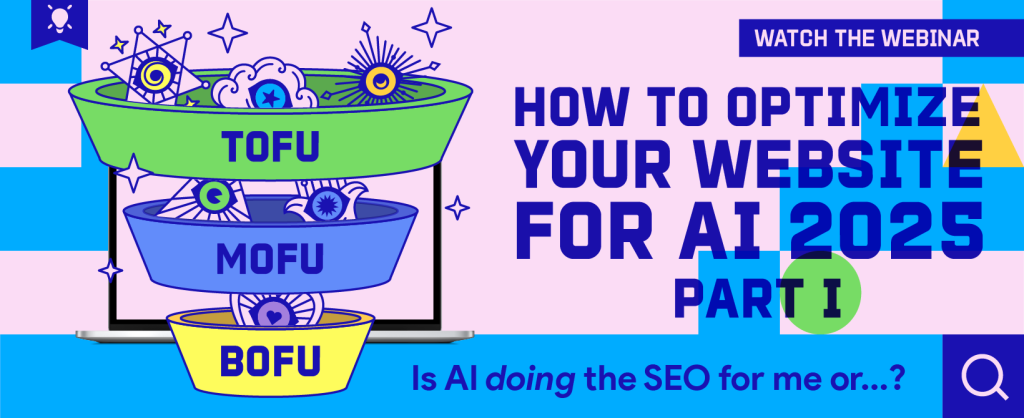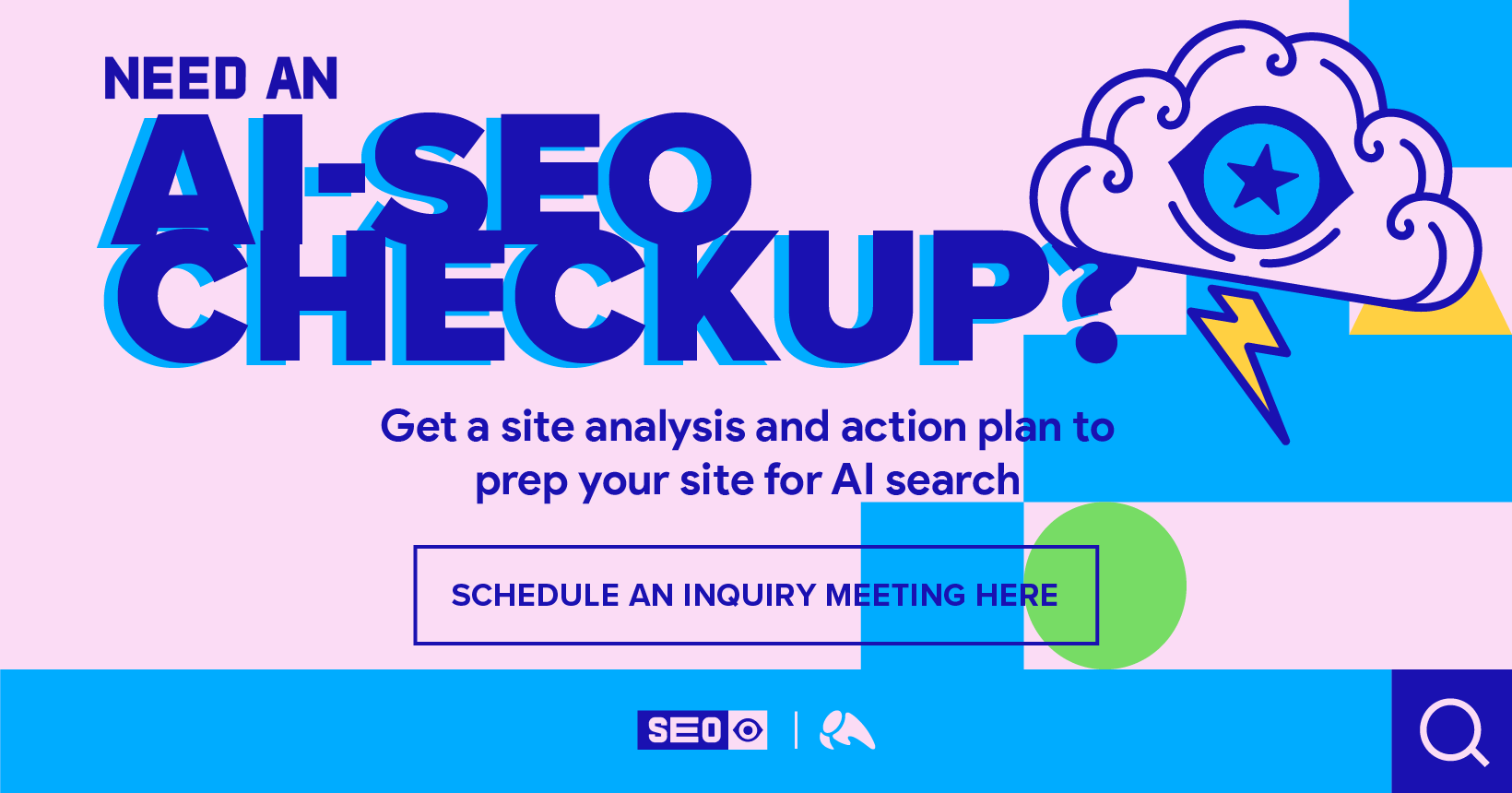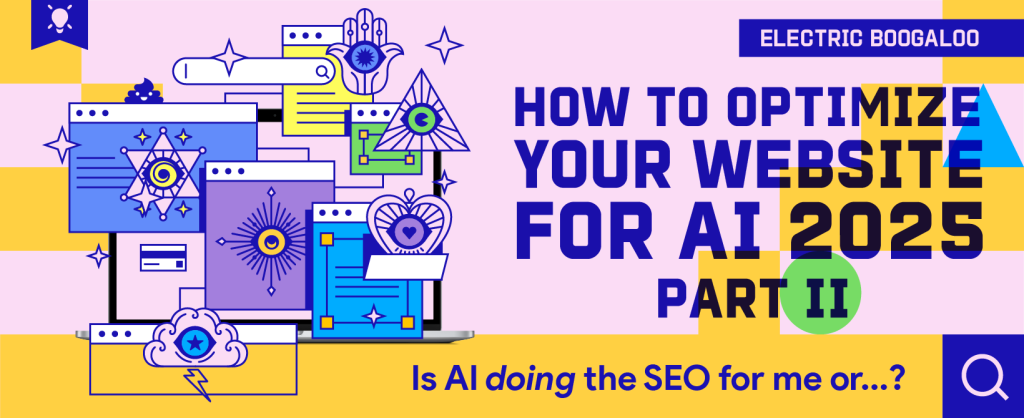
In this two-part blog series, we’re giving you sneak previews of an upcoming Overit eBook on AI optimization for websites. These two posts are focused on advice for content and editorial teams. If you’re looking for clear and actionable tips for writing content with AIs and LLMs in mind, then keep reading!
Now, the practice of optimizing your website and brand for AI has many names, and we’ll use them interchangeably: AI-SEO, AIO, GEO, AEO. They are all about answering the question “How do I get my website to show up in ChatGPT?” and that’s what we’re after, together, here.
In this Part 1 post, we’ll cover some “micro” AI-SEO writing tips that apply at the page or article level. Part 2 will cover more “macro,” high-level considerations for your overall content marketing architectures and strategies.
Before we dive in, here’s a video of a recent discussion I had on AI-SEO with my colleagues at Overit.
Watch: Overit Webinar on AI-SEO from July 2025
OK, now on to Part 1…
AIO Tip #1: Use Natural, Clear, and Concise Language
Perhaps the most important tip we can give you is to write naturally, as you would for a human. Whereas search engine users have long written in non-syntactical queries (such as “cheapest red Nikes size 10”), users will interact with LLMs with a far more natural and conversational style: “ChatGPT, what are the cheapest red Nikes you can find on sale? I’m a size 10.” Your content should reflect the natural language that users will prompt the AI with, not the fragmented, keyword driven queries that characterize search engines.
A lot of the practical writing advice you would receive in high school or undergraduate studies apply to LLMs as much as they do humans. Some practical tips for overall language usage are:
-
- Avoid Jargon and Tech Talk. To the degree that you can, try to avoid needless jargon or overly-technical language. When you must use this type of language, make sure it’s appropriate for the intended audience. The first time you introduce a new technical term, define it right there in the context of the content or link out to a glossary definition of the term.
- Write smaller, clearer sentences. Try to avoid overly complex sentence and grammatical structures, ones that have multiple and/or nested clauses. Break more complex and unwieldy sentences into smaller sequential sentences.
- Be Active, Not Passive. Use the Active voice, where the subject of a sentence takes direct action and does something. Avoid the passive voice, where the objects of sentences have no agency but rather things done unto them.
- Avoid Uncertainty. Try to avoid ambiguity and unclear phrasing, particularly when sections of text have multiple subjects, objects, verbs, and/or adjectives. For example, the sequence of sentences “The man threw the ball to his friend wearing a shirt. It was red. He liked it” is very unclear and ambiguous in meaning. What was red? The shirt or the ball? Who is “he”, the man throwing the ball or his friend? What did he like, the red shirt or the ball? Make the relationships between the different parts of the sentence clear and unambiguous.
- Use topical introductions. Structure your content with paragraphs as a primary unit of organization and use topical introductions at every level of scale within content. Write out clear and overarching topic sentences that introduce the main ideas to follow in the rest of the paragraph. Similarly, use topic paragraphs to introduce longer sections of text made up of many paragraphs. Like this eBook, even use topic/introductory sections or chapters, if the content is long enough.
Need help getting your brand covered in AI search?
Request an Overit AI-SEO Checkup>>
AIO Tip #2: Structure Content Modularly and Use Transitional Phrases
The longer a piece of content is, the more critical it is to have useful and clear labels and headings that break up the overall piece of content into smaller and more “modular” blocks. Use section, subsections and even sub-subsection titles or headings. Adopt and maintain consistent heading hierarchies (H1-H6) for the different levels and scales of the content. Just as human readers could now easily “scan” the content headings to get a better idea of what information is contained within it, so can LLMs.
Get Chunky
Search engines have already integrated “passage-based indexing” for Featured Snippets and LLMs take this capability even further. With proper labeling and modular “chunking” of the content, LLMs can readily find and surface the most relevant section of text within a longer piece of content and/or effectively summarize long-form content into short, distilled and easily digestible sentences.
Use Transitions to Bookend Individual Ideas
Even when chunking out content effectively, it’s important to effectively transition from one section to another. Keep in mind good writing practices, with introductory and topical content for each main “unit” of writing: a topic sentence, or an introductory paragraph or even an introductory chapter. As you move through your content as a whole, you should be including transitional words and phrases and paragraphs within these introductions, ones that connect the current section/unit back to the prior one(s).
The most basic but also poorest transition is an “and.” You simply write a sentence. And then you write another. It compounds and aggregates, but there is no other relationship between the ideas. However, “but” is a better transition. So is “however.” They both indicate a degree of contrast or difference. Therefore, we might use them more than we’d use an “and.”
See how I reached a conclusion there and prefaced it logically with a “therefore”? That’s another type of transition you might use, one grounded in logic, which LLMs love. So too are any “If-Then” pairings. Use those too where you can, or else you might regret it. Oh yeah, don’t forget your “else” clauses!
Use Clarifying Content Presentation Tools
Besides the labeling of section headers within the content, there are a few other content design and presentation decisions that can help improve readability for LLMs. Accordions, content cards, and content tiling can all be beneficial in organizing the content in inherently modular formats.
AIO Tip #3: Provide Navigational Cues and Internal Links for Deeper Semantic Relevancy
Besides aiding the comprehension of content, another area where you can assist AI’s is by providing them broader context to individual pieces of content. This means how one piece of content relates to another or others as a larger “whole’. We’ve already mentioned Breadcrumbs as one way to show website structure and hierarchies to LLMs. Internal linking to other pieces of different but related content can also help provide the deeper contexts that LLMs seek to acquire.
The internal linking from related pieces of content on a website create topical “clusters”. These provide deeper context for your content to the LLMs and allow them to interpret and situate not just one piece of content, but multiple ones across a website. Topical breadth, depth, and subject matter authority are all signaled to the LLMs in this manner. They also can ascertain and summarize information about your website and organization as a whole now, not just comprehend one piece of content on your site.
Just be sure to use relevant, meaningful and optimized anchor texts for your internal links. Avoid the generic “Click here” and “Learn More” style of anchor texts. Use more relevant and meaningful words for anchor texts, ones that reflect the type of content contained on the page being linked to.
Need help getting your brand covered in AI search?
Request an Overit AI-SEO Checkup>>
AIO Tip #4: Use FAQs, Tables, and Lists to Present Information and Data
As you might tell by now, LLMs and AI agents do well in interpreting content that is highly organized and structured. We’ve discussed using section headings already, but there are also other ways you can help LLMs better understand the type of content you are presenting.
- LLMs love FAQs: For information that can be presented in a Questions and Answers format, structure your content in this manner. Create a question under an appropriate Heading tag and then answer the question directly below it. There is even a specific Schema markup type for FAQ pages called FAQPage to identify the purpose and format of the page as a whole.
- Put it all out in the table: For information that can be easily organized into rows and columns use Tables. One of the oldest and most basic HTML tags are for tables, yet many modern websites use CSS and/or Javascript tricks to create what LOOK like tables but are not actually organized semantically as such. Go back to the basics and use ordinary Table formatting in HTML. This is great for presenting numerical data or making comparisons for different items across multiple categories, such as within a consumer’s purchasing guide.
- This bullet is about using bullets (and numbers): For information that can be organized into discrete steps or elements within a list, use both Ordered (Numbered) or Unordered (Bulleted) Lists. There are also old-fashioned HTML tags designed specifically for presenting information in List format. For “How-to” content, be sure to break down the process into small and manageable steps and order them sequentially.
That’s it for the Part 1 post. Stay tuned for our upcoming Part 2 post on “How to Write Website Content for AI Optimization.”






